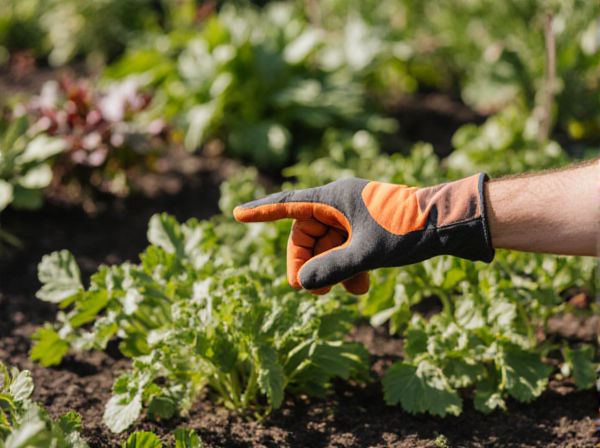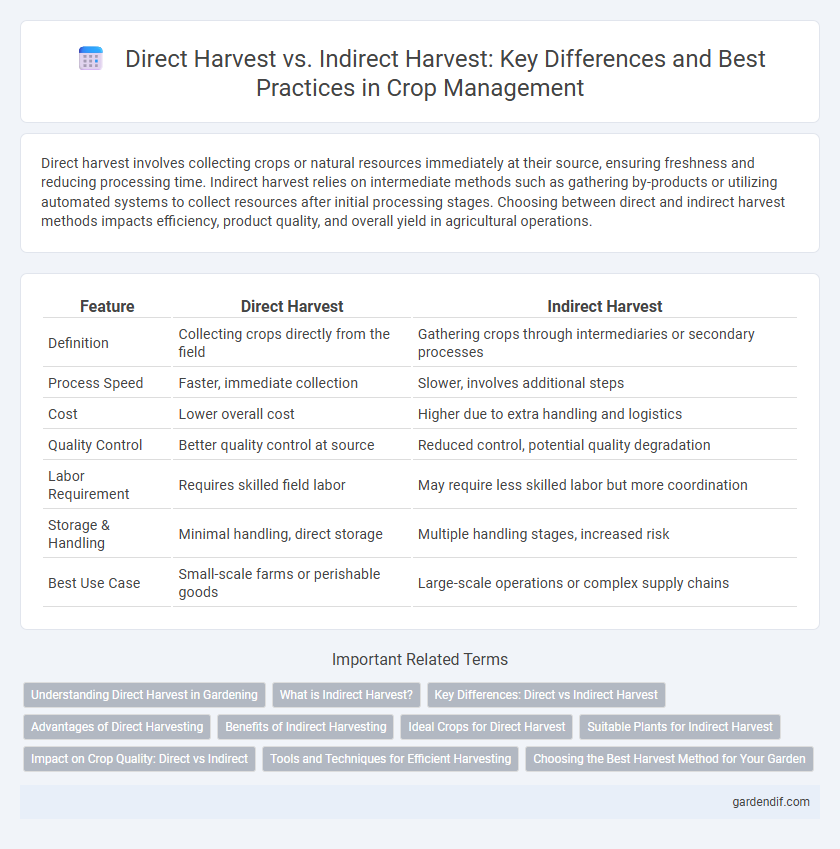
Direct Harvest vs Indirect Harvest Illustration
Direct harvest involves collecting crops or natural resources immediately at their source, ensuring freshness and reducing processing time. Indirect harvest relies on intermediate methods such as gathering by-products or utilizing automated systems to collect resources after initial processing stages. Choosing between direct and indirect harvest methods impacts efficiency, product quality, and overall yield in agricultural operations.
Table of Comparison
| Feature | Direct Harvest | Indirect Harvest |
|---|---|---|
| Definition | Collecting crops directly from the field | Gathering crops through intermediaries or secondary processes |
| Process Speed | Faster, immediate collection | Slower, involves additional steps |
| Cost | Lower overall cost | Higher due to extra handling and logistics |
| Quality Control | Better quality control at source | Reduced control, potential quality degradation |
| Labor Requirement | Requires skilled field labor | May require less skilled labor but more coordination |
| Storage & Handling | Minimal handling, direct storage | Multiple handling stages, increased risk |
| Best Use Case | Small-scale farms or perishable goods | Large-scale operations or complex supply chains |
Understanding Direct Harvest in Gardening
Direct harvest in gardening involves collecting mature fruits, vegetables, or herbs immediately from their plants at peak ripeness, ensuring maximum freshness and nutrient content. Unlike indirect harvest, which relies on post-harvest ripening or processing, direct harvest emphasizes timely picking to maintain optimal flavor and quality. Gardeners practicing direct harvest benefit from precise timing and careful handling to reduce spoilage and maximize yield.
What is Indirect Harvest?
Indirect harvest refers to forest management practices that promote natural regeneration by creating conditions favorable for tree growth without immediate tree removal. This method relies on ecological processes such as seed dispersal and sprouting, enhancing biodiversity and soil stability. Indirect harvest contrasts with direct harvest, which involves physically cutting and collecting timber.
Key Differences: Direct vs Indirect Harvest
Direct harvest involves collecting crops or products immediately from their natural source, ensuring freshness and minimal processing time, crucial for fruits, vegetables, and certain grains. Indirect harvest refers to gathering intermediate products or residues for further processing, often used in bioenergy or secondary agricultural products, allowing flexibility in timing and resource use. Key differences include the immediacy of collection, product quality preservation, and the purpose of harvesting, with direct harvest focusing on immediate consumption or sale, while indirect harvest supports extended use or value addition.
Advantages of Direct Harvesting
Direct harvesting enhances crop quality by minimizing damage and preserving freshness, leading to higher market value and better consumer satisfaction. It reduces post-harvest losses and labor costs by eliminating intermediary processes such as threshing or threshing separation. This method also ensures faster processing times, allowing for timely delivery and maintaining optimal nutritional content in the harvested produce.
Benefits of Indirect Harvesting
Indirect harvesting improves crop quality by minimizing damage to plants and soil structure, promoting sustainable agriculture. It enhances resource efficiency through targeted collection methods that reduce waste and preserve nutrients. This approach supports long-term yield stability by maintaining ecosystem health and biodiversity.
Ideal Crops for Direct Harvest
Ideal crops for direct harvest include tomatoes, strawberries, apples, and leafy greens, which can be picked directly from plants without further processing. These crops benefit from minimal handling, preserving freshness and reducing labor costs. Direct harvest methods optimize quality and marketability by enabling immediate post-harvest cooling and packaging.
Suitable Plants for Indirect Harvest
Suitable plants for indirect harvest include leafy greens, root vegetables, and herbs, as they can regenerate after partial harvesting without damaging the entire plant. Crops like lettuce, spinach, carrots, and basil benefit from indirect harvest techniques such as selective leaf picking or partial root extraction, promoting continuous growth and multiple harvest cycles. This method enhances yield sustainability and reduces plant stress compared to direct harvest approaches that remove the entire crop at once.
Impact on Crop Quality: Direct vs Indirect
Direct harvest methods generally preserve crop quality better by minimizing handling and reducing exposure to contaminants, which helps maintain freshness and nutritional value. Indirect harvest often involves additional processing steps that can lead to mechanical damage and increased risk of spoilage, negatively affecting texture and flavor. Choosing direct harvest techniques optimizes crop quality by ensuring minimal disruption to the produce from field to market.
Tools and Techniques for Efficient Harvesting
Direct harvest utilizes specialized tools such as combine harvesters and forage harvesters designed to cut and collect crops in a single pass, maximizing efficiency and reducing labor time. Indirect harvest often involves multiple steps, including initial cutting with sickles or mowers, followed by separate collection and threshing processes, which may require additional equipment like threshers and rakes. Employing modern GPS-guided machinery and automated sorting systems enhances precision and productivity in both direct and indirect harvesting methods.
Choosing the Best Harvest Method for Your Garden
Direct harvest involves picking crops as they reach maturity, ensuring peak freshness and nutrient retention, while indirect harvest relies on collecting fruits or vegetables before full ripeness to ripen post-harvest. Choosing the best harvest method depends on the specific crop type, climatic conditions, and intended use, with direct harvest offering immediate consumption benefits and indirect harvest providing extended storage options. Gardeners should evaluate factors such as crop sensitivity, market demands, and timing to optimize yield quality and reduce post-harvest losses.
Direct Harvest vs Indirect Harvest Infographic

 gardendif.com
gardendif.com